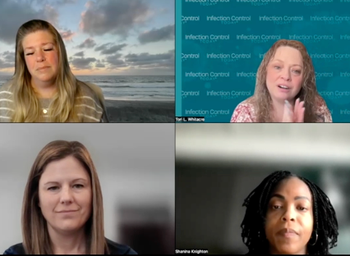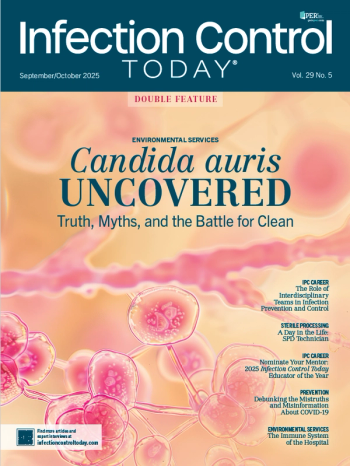
Truly Effective Communication Takes a Team
By Nathalie Walker, MBA, RN, CNOR
In our journey toward value-based care, healthcare has taken a closer look at the underlying causes for errors and a lack of quality care. One major area that we continue to struggle with is how we communicate effectively with each other. In fact, 70 percent of adverse events in the surgical environment are caused by breakdowns in communication among healthcare providers.1
We know that clear communication between surgical team members and infection preventionists is very important for patient safety. Consider the potential for patient harm when communications break down between surgery and infection prevention for critical patient safety practices, such as antibiotic timing, MRSA screening, and correct skin antisepsis.
Despite practitioner knowledge of evidence-based professional practice recommendations for these aspects of care, communication breakdowns can prevent safe practices from being correctly implemented consistently.
That’s why AORN has shaped a new Guideline for Team Communication, which outlines evidence-based approaches to fill the communication gaps among perioperative team members and other healthcare providers they work with ranging from our colleagues in infection prevention, sterile processing, pharmacy and beyond.
Rewiring for Team Communication
Research has uncovered the importance of a safety culture based on the principles of high reliability, including coordination, cooperation, cognition, conflict resolution, coaching and, yes, communication.2 This evidence demonstrates how a culture of safety instead of safety culture) safety culture can be achieved through development of nontechnical skills such as situational awareness, decision making, leadership, communication and teamwork.
When these skills become ingrained in standardized processes as part of the cultural norm within a health care facility, patients can experience safe, high quality care and health care facilities can maximize reimbursements from the federal government and other payers who require a demonstrated focus on all aspects of value-based care.
Hard-wired barriers such as hierarchical and personal relationships, educational background, language preference, culture, race, and gender3 can prevent communication between healthcare professionals. However, rewiring is possible with a shared focus on these nontechnical skills that improve our collective ability to work together.
Take the concept of adopting a shared mental model2 prior to a surgical procedure. By establishing a cue for stakeholders to meet and discuss shared goals and potential risks, each team member can have an aligned view for how their role fits into the bigger picture of achieving that shared goal. The result is less need for last-minute changes and distractions that can disrupt or delay care.
This shared mental model is relevant in practices that involve surgery and infection prevention. For example, consider the streamlined and time-sensitive communications that must take place if a vector is observed in the OR during a procedure. This creates a potential break in sterile technique that requires the RN circulator to report the incident to the charge nurse and submits an incident report which alerts risk management of the incident with the goal to ensure the patient is observed for increased risk of developing a postoperative infection. Each specialist can benefit from establishing the same goals for infection awareness and diligence early on. A similar communication chain would be required if a preoperative patient tests positive for MRSA, requiring the preoperative nurse to communicate expediently with infection prevention prior to the surgery so necessary decolonization and isolation precautions can be put in place.
Another example of the need for communication strategies as part of a shared mental model between surgery and infection prevention involves antibiotic administration. Consider the value of discussing the timing for the administration of the correct antibiotic during the “Time Out” briefing. Each surgical procedure differs in the time it takes to transport the patient from the pre-procedure area until the incision is made. The antibiotic needs to be administered within one hour of the incision. Discussing optimal administration time of the antibiotic, and having a communication mechanism for accountability promotes achieving optimal benefit of the use of antibiotics in the prevention of surgical site infections.
Starting the Conversation
It makes sense that adopting team communication strategies can help us address critical practice issues we need to improve on. The key to success is approaching communication education, training and new processes in a way that is meaningful for all team members. Begin by drilling down to specific communication breakdowns you want to focus on. Then pull together the interdisciplinary stakeholders involved in the incident and discuss key aspects necessary communication standardization.
I encourage all healthcare professionals to review AORN’s new Guideline for Team Communication with an open mind and an eye on ways they can collaborate with colleagues to implement evidence-based approaches to effectively communicate in their own practice setting.
As reforms in payment models and care delivery continue to reshape our professional practice and the ways we approach patient care, they also challenge us to embrace new opportunities for learning and collaborating with our colleagues. Bring an evidence-based approach to team communication in your practice setting with AORN’s new Guideline for Team Communication in the 2018 edition of Guidelines for Perioperative Practice available at www.aorn.org/guidelines.
Nathalie Walker, MBA, RN, CNOR, is president of the Association of periOperative Registered Nurses (AORN). She has been a perioperative nurse for 24 years, with roles ranging from staff nurse, manager, and educator of perioperative services. She is also a member of the Louisiana Nursing Supply and Demand Commission, a subcommittee of the Health Works Commission of Louisiana.
References:
1. Update: Sentinel event statistics. Jt Comm Perspect. 2006;26(10):14-15.
2. Wahr JA, Prager RL, Abernathy JH, et al. Patient safety in the cardiac operating room: Human factors and teamwork: A scientific statement from the American Heart Association. Circulation. 2013;128(10):1139-1169.
3. Gillespie BM, Withers TK, Lavin J, Gardiner T, Marshall AP. Factors that drive team participation in surgical safety checks: A prospective study. Patient Saf Surg. 2016;10(1). doi: 10.1186/s13037-015-0090-5.
Newsletter
Stay prepared and protected with Infection Control Today's newsletter, delivering essential updates, best practices, and expert insights for infection preventionists.





